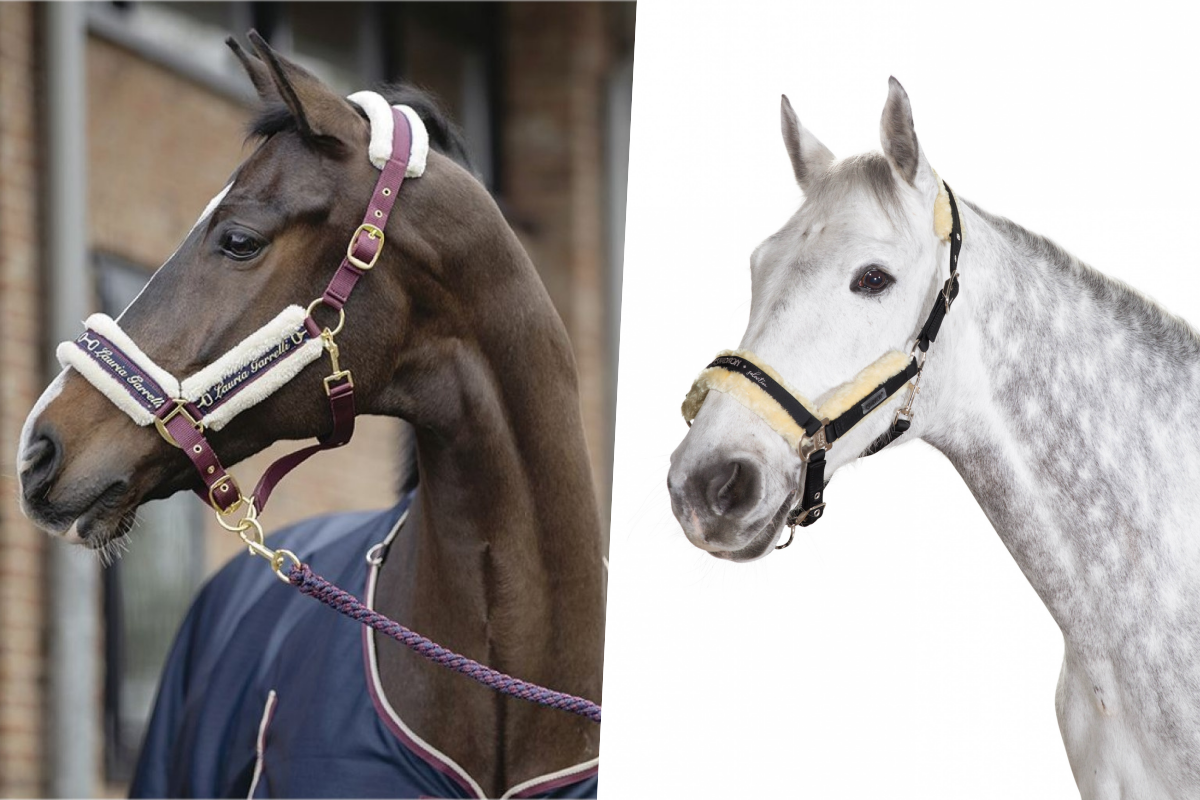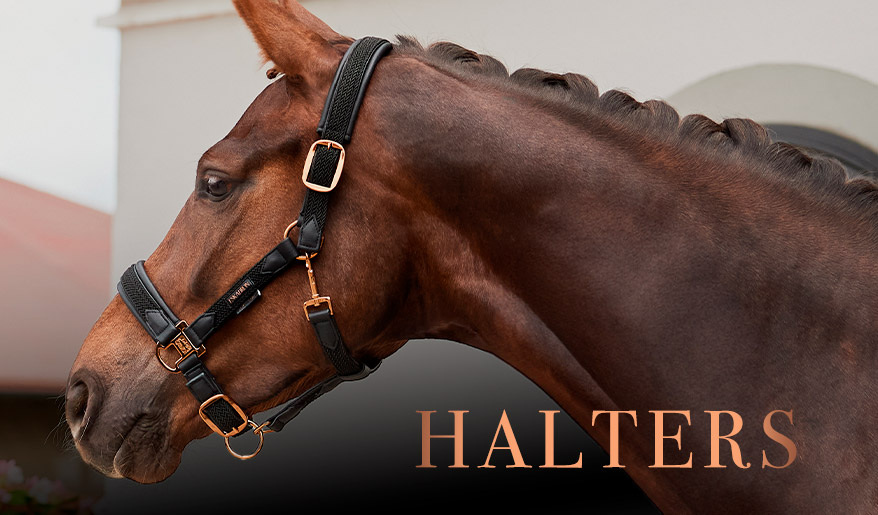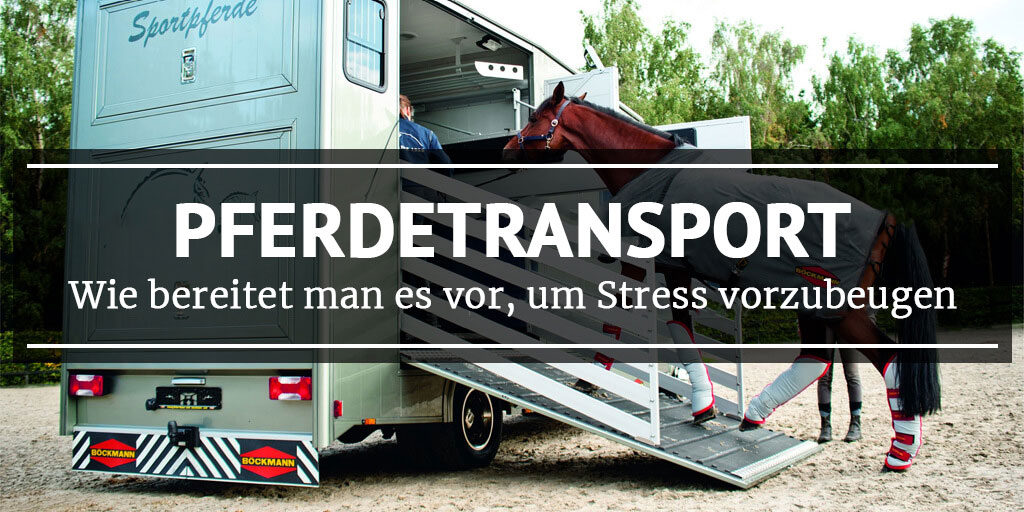
Quelle: boeckmann.com
Juni, Juli und August sind die intensivsten Perioden der Reitsaison. Uns stehen viele Wettkämpfe bevor, nicht immer auf dem Gelände unseres Stalles oder in dessen Nähe. Manchmal ist es notwendig, unser Pferd zu transportieren, was mehrere hundert Kilometer erreichen und mehrere Stunden dauern kann. Ist unser Schützling darauf vorbereitet? Oder ist der Transport vielleicht der am wenigsten angenehme Teil des Turniers, stressig für uns und unser Pferd?
Denken Sie daran, dass es nie zu spät ist, den Komfort unseres Rosses zu verbessern. Nachfolgend finden Sie einige Tipps, wie Sie Ihre Fahrt angenehmer gestalten und die frustrierenden Situationen beim Be- und Entladen der Vergangenheit angehören lassen.
1. Vorbereitung der Transportmittel
Wir unterscheiden zwischen zwei grundsätzlichen Autotransportmitteln, mit denen wir unser Pferd transportieren können.
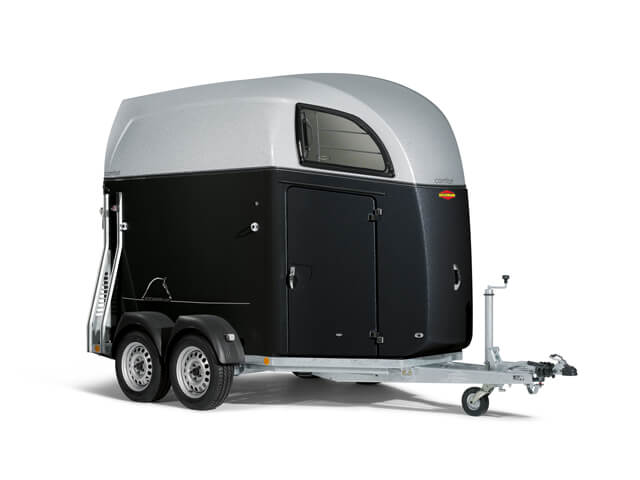 Anhänger für zwei Pferde, Quelle: boeckmann.com
Anhänger für zwei Pferde, Quelle: boeckmann.comEin Anhänger (sog. Bukmanka, nach dem Namen der deutschen Firma Böckmann) - ausgelegt für zwei parallel zueinander stehende Pferde. Es hat Platz für einen kleinen Kofferraum, der einige Reitausrüstung aufnehmen kann, mit Sattelhaken. Der Anhänger kann von hinten oder von vorne bestiegen werden, sodass das Beladen sehr einfach ist, auch aufgrund des geringen Neigungswinkels der Gang Wegs zum Boden.
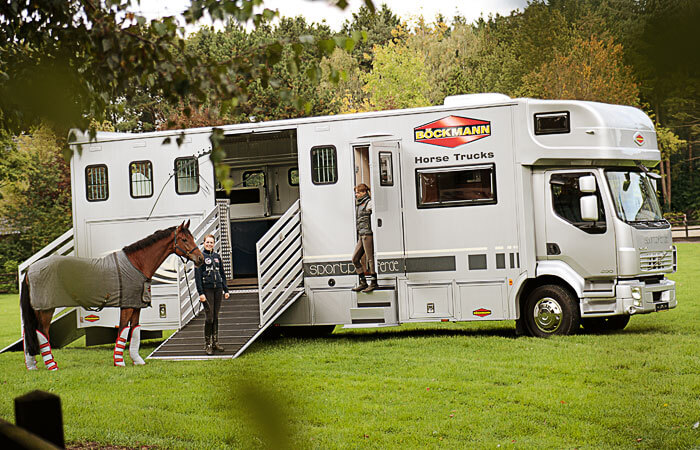 Pferdewagen für 10 Pferde, Quelle: boeckmann.com
Pferdewagen für 10 Pferde, Quelle: boeckmann.comPferdewagen - je nach Größe können Sie darin 2 bis 12 Pferde transportieren. Wir finden hier viel Platz für Reitausrüstung und sonstiges Gepäck. Diese wirklich "geilen" Pferdetransporter haben auch Übernachtungsplätze, eine Küche und eine Toilette im Inneren, dank derer wir während des Wettbewerbs selbständig sind und kein Geld für die Unterkunft ausgeben müssen. Ein weiterer Vorteil des Pferdewagens ist die Möglichkeit, das Pferd vorwärts zu führen. Der Nachteil dieser Art des Transports ist jedoch der hohe Neigungswinkel der Rampe zum Boden.
 Der Innenraum des Pferdewagens Oakley Supremacy für 6 Pferde, mit Platz für 6 Personen, Quelle: oakleyhorseboxes.co.uk
Der Innenraum des Pferdewagens Oakley Supremacy für 6 Pferde, mit Platz für 6 Personen, Quelle: oakleyhorseboxes.co.ukHandelt es sich um unser eigenes Transportmittel, lohnt es sich, nach dem Winter den technischen Zustand zu überprüfen – die Funktionsfähigkeit der Auflaufbremse, den Zustand der Reifen, den Reifendruck und allerlei Schlösser, Griffe, Riegel und Beleuchtung. Überprüfen Sie auch, ob sich im Fahrzeug scharfe Gegenstände (Nadeln, Nägel, Schrauben usw.) befinden, die dem Pferd schaden könnten. Solche Schnitte können nicht nur die Teilnahme an Wettkämpfen ausschließen, sondern tragen auch zu dauerhaften Verletzungen bei.
Am besten ist es, wenn die Innenwände des Fahrzeugs mit Gummi belegt sind und sich auf Höhe des Pferdeoberkörpers eine Matratze befindet. Beim Fahren finden Pferde ihr Gleichgewicht sehr oft, wenn sie an die Wand gelehnt sind. Das Fehlen der zuvor erwähnten Stoßdämpfer verursacht schmerzhafte Abschürfungen beim Pferd, besonders im Bereich des Hüfthöckers.
Auch der Boden und die Rampe, an der die Pferde aufsteigen, sollten gut gesichert sein. Am besten sind sie mit Gummi unterlegt und haben Quersprossen, um ein Abrutschen beim Reingehen zu verhindern. Um boxähnliche Bedingungen zu gewährleisten und die Amortisation zu verbessern, werden Pferde oft auf Einstreu - Stroh, Sägemehl - transportiert. Es lohnt sich, eine ziemlich dicke Schicht zu legen, damit sie ohne Rutschgefahr auf der nassen Einstreu urinieren können. Denken Sie während des Transports jedoch daran, dass sich einige der Pferde beim Stuhlgang während der Fahrt nicht so wohl fühlen, und man sollte dies in der Fahrtpause mit dem Pferd machen, es rausbringen, bis es sich um seine Bedürfnisse gekümmert hat.Es ist auch eine gute Idee, ein Heunetz für die Reise vorzubereiten, damit unsere Pferde den Ritt positiv sehen und ihre ganze Aufmerksamkeit auf das Heufressen richten können - für die meisten wirkt es beruhigend und lässt den Stress vergessen.
2. Wie man in den Anhänger einsteigt
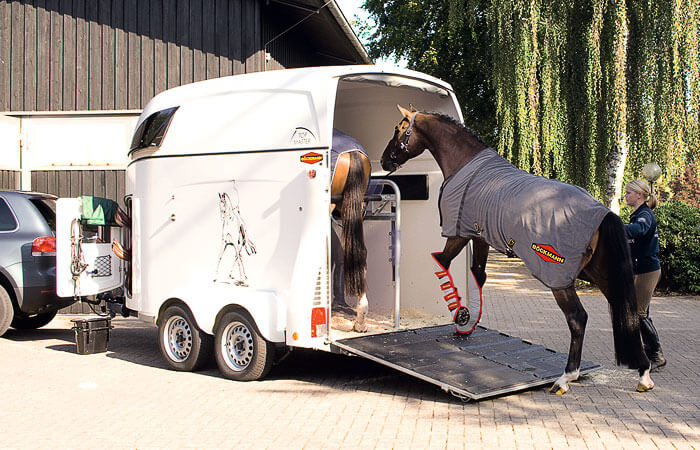
Quelle: boeckmann.com
Viele von uns vergessen, dass das Wissen, wie man ein Pferd in einen Anhänger bringt, ein langer Prozess ist, der einige Minuten vor der geplanten Abfahrt nicht überstürzt werden kann. Leider durchlaufen die meisten Pferde dieses Training nicht und ein sehr häufiges Bild auf Turnieren ist ein gestresstes Pferd, das durch Gewalt und Drohungen (Ziehen, Tritte, Peitsche) einfach in einen Anhänger geschoben wird. Es spricht nicht gut für den Reiter oder Pferdebesitzer und ist ein wirklich unangenehmer Anblick.
Es reicht aus, ein wenig Zeit damit zu verbringen, damit das Pferd nur positive Erinnerungen an unseren Pferdewagen oder -anhänger hat. Besonders das mehrmalige Einführen (ohne Gewaltanwendung!) und Füttern des Pferdes weckt starke positive Assoziationen, dass es kein Problem mit dem Aufsteigen und Reiten hat.
Die erste Stufe des Trainings sollte darin bestehen, das Pferd mit der Ansicht eines Anhängers oder eines Pferdewagens vertraut zu machen. Am besten stellen Sie einen geschlossenen Anhänger an einem unserem Pferd wohlbekannten Ort, z.B. auf der Weide, wo es in Gesellschaft anderer Pferde an ihm schnüffeln und sich an seine Anwesenheit gewöhnen kann.
Der nächste Schritt sollte sein, den Anhänger zu öffnen und das Pferd reinzuführen, das ohne unnötigen Stress hineingeht und der Anhänger es nicht mehr beeindruckt. Die Anwesenheit eines anderen Pferdes im Anhänger wird unser Pferd ermutigen und seinen Stress in der neuen Situation reduzieren. Während des gesamten Lernprozesses erweisen sich die Belohnungen in Form von Leckereien, Karotten, als sehr nützlich, weil sie positive Erinnerungen für das Pferd in Bezug auf die Ankunft des Transportmittels aufbauen. Natürlich kann das erwähnte Lob von einem Pferd erst gegeben werden, nachdem die Aufgabe ordnungsgemäß erfüllt wurde, damit es weiß, dass es verdient werden muss.
Das Einsteigen in den Anhänger lernt man in kleinen Schritten – im wahrsten Sinne des Wortes. Wir belohnen das Pferd nach und nach dafür, dass es das Vorderbein auf den Gang Weg gelegt hat (wir müssen es normalerweise selbst anheben und darauf legen), und dann ein weiteres Vorderbein usw. Man sollte das Pferd ermutigen, dass es nächste Schritte auf dem Gang Weg selber macht, indem wir ihm eine Karotte vor die Nase zeigen, die es auch mit ausgestrecktem Hals nicht erreichen kann, sondern nur, wenn es einen Schritt macht (auch wenn er klein ist, sollte dies belohnt werden).
Denken Sie daran, dass das Pferd das Reingehen während des Trainingsprozesses aufgeben kann. Dann lassen Sie es von der Rampe runter, auch wenn es schon vier Beine drauf hatte. Das Tier muss spüren, dass wir es nicht unter Druck setzen und dass es nur Spaß ist. Wenn es trotz des unvollständigen Versuchs nicht mehr hineingehen möchte, sollten Sie es lassen und am nächsten Tag wieder trainieren.
Wenn sich das Pferd dank unserer Geduld und Bemühungen endlich im Anhänger wiederfindet, soll es üppig mit Heu im Netz belohnt werden, das zu einem untrennbaren Bestandteil des Anhängers werden und es dort für eine Weile festhalten soll. Wir können es mit unserer Anwesenheit, Stimme oder Streicheln unterstützen. Es lohnt sich auch zu versuchen, den Anhänger zu schließen, damit sich auch das Pferd daran gewöhnt.
Natürlich kennen wir unser Pferd und sehen, ob wir loslassen sollten oder ob die Situation für unser Tier zu stressig geworden ist. Denken Sie daran, dass Sie es nicht übertreiben dürfen und es besser ist, die nächsten "Schritte" auf den nächsten Tag zu verschieben. Einige Pferde werden nach ein paar Minuten einsteigen, andere können bis zu zwei Wochen brauchen, um sich daran zu gewöhnen.
Wir müssen auch damit rechnen, dass das Verlassen des Pferdeanhängers viel gefährlicher sein kann. Man sollte andere Personen um Hilfe bitten, die dafür sorgen, dass unser Reittier weiterhin auf der Rampe läuft. Das Pferd zieht sich oft nicht perfekt in einer geraden Linie zurück, daher sollte man auf die Kruppe drücken und darauf achten, dass es nicht mit den Hinterbeinen zu den Seitenkanten der Rampe hinabsteigt. Ein solches Bein, das die Rampe überspringt, kann eine ziemlich schwere Verletzung verursachen und die positiven Erinnerungen an das Pferd, das wir beim ersten Kontakt mit dem Anhänger aufbauen, ruinieren.
3. Reisebegleitung
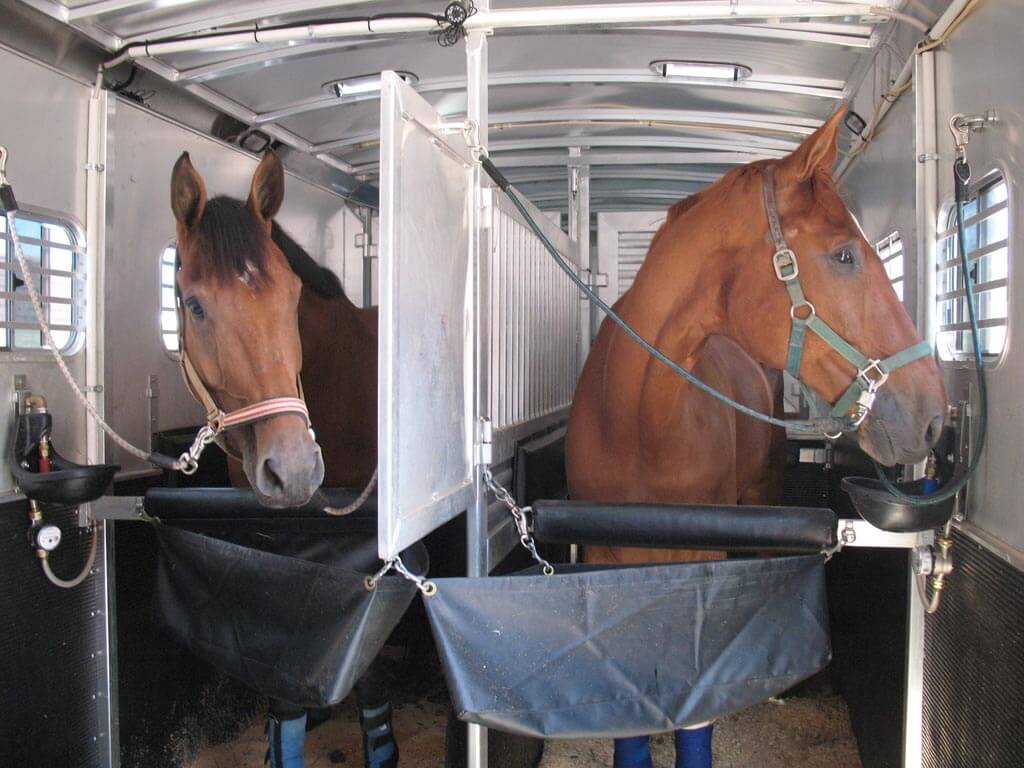 Quelle: horselimousine.com
Quelle: horselimousine.comWenn Ihr Pferd sich nicht sehr wohl auf Reisen fühlt, lohnt es sich, ein anderes Pferd mitzunehmen, weil es als Herdetier mit einem Begleiter weniger gestresst ist. Ein Begleitpferd muss unser Ross kennen (ein Freund aus dem Nachbarstall wäre toll!) und natürlich mögen. Dadurch vermeiden wir eine Situation des Kennenlernens der Pferde im Anhänger, was oft mit nervösem Quietschen, Schnüffeln, Treten mit den Vorder- oder Hinterbeinen (besonders bei Hengsten) einhergeht. So ein fremdes Pferd wird den Stress unseres Tieres sicherlich nicht mindern, und kann nur Verletzungen am Pferd und Schäden an der Ausrüstung verursachen.
Natürlich ist es nicht die beste Idee, einen Hengst mit einer Stute zu transportieren. Selbst solide aussehende Ausrüstung und eine Pferdetrennwand können sich als zu schwach gegen die Masse und Stärke von vierbeinigen Pferden erweisen. Wenn wir bereits eine Stute mit Hengst transportieren müssen, trennen Sie sie mit einem Wallach oder lassen Sie Leerplätze dazwischen, was nur in einem Pferdewagen möglich ist.
4. Pferd im Transport
Die Hersteller von Reitausrüstung bieten uns ein umfassendes Sortiment an verschiedenen Gamaschen, die die Sicherheit unseres Pferdes gewährleisten, an.
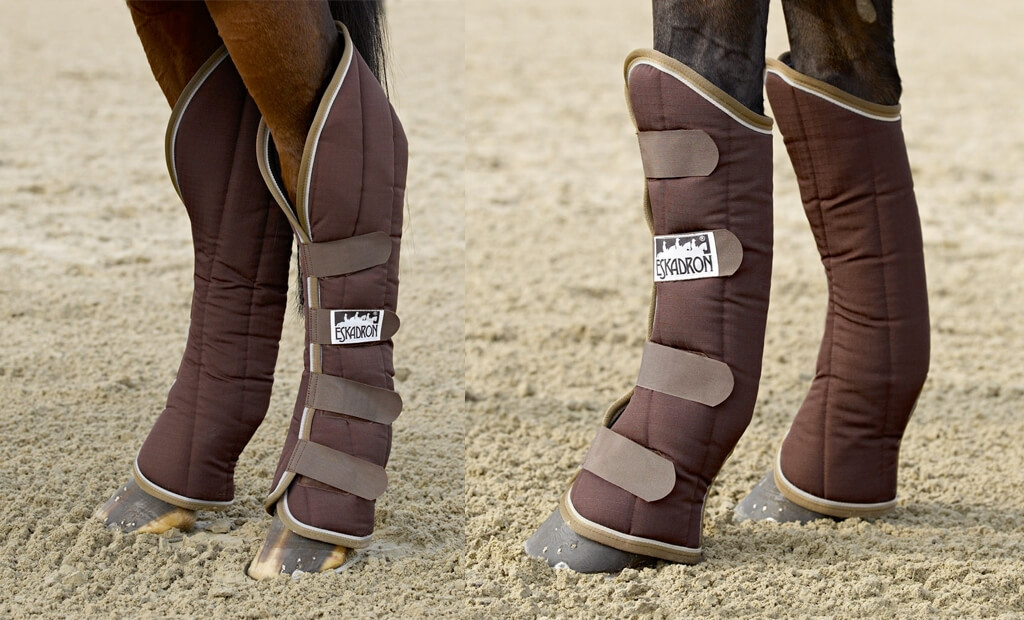
Eskadron RIPSTOP Transportgamaschen
Transportgamaschen - Sie sind perfekt für unterwegs und schützen die Beine von den Hufen bis zum Handgelenk und Sprunggelenk. Leider sind die Gamaschen aufgrund ihrer Größe schwer zu waschen, passen nicht in eine handelsübliche Waschmaschine und rutschen oft von den Beinen eines nervös trampelnden Pferdes. Für nicht daran gewöhnte Pferde kann es schwierig sein, sie in den Anhänger zu bekommen, weil sich einige Pferde nur sehr ungern darin bewegen.
Unterlagen, Bandagen, Glocken – manche Besitzer nutzen sie lieber anstelle von Transportgamaschen. Pferde sind besser daran gewöhnt, sie schränken ihre Bewegungen nicht ein, sie sind billiger und leicht zu waschen. Allerdings schützen sie nicht so perfekt wie die für den Transport gedachten und ihre Anbringung (insbesondere von Bandagen) erfordert Übung.
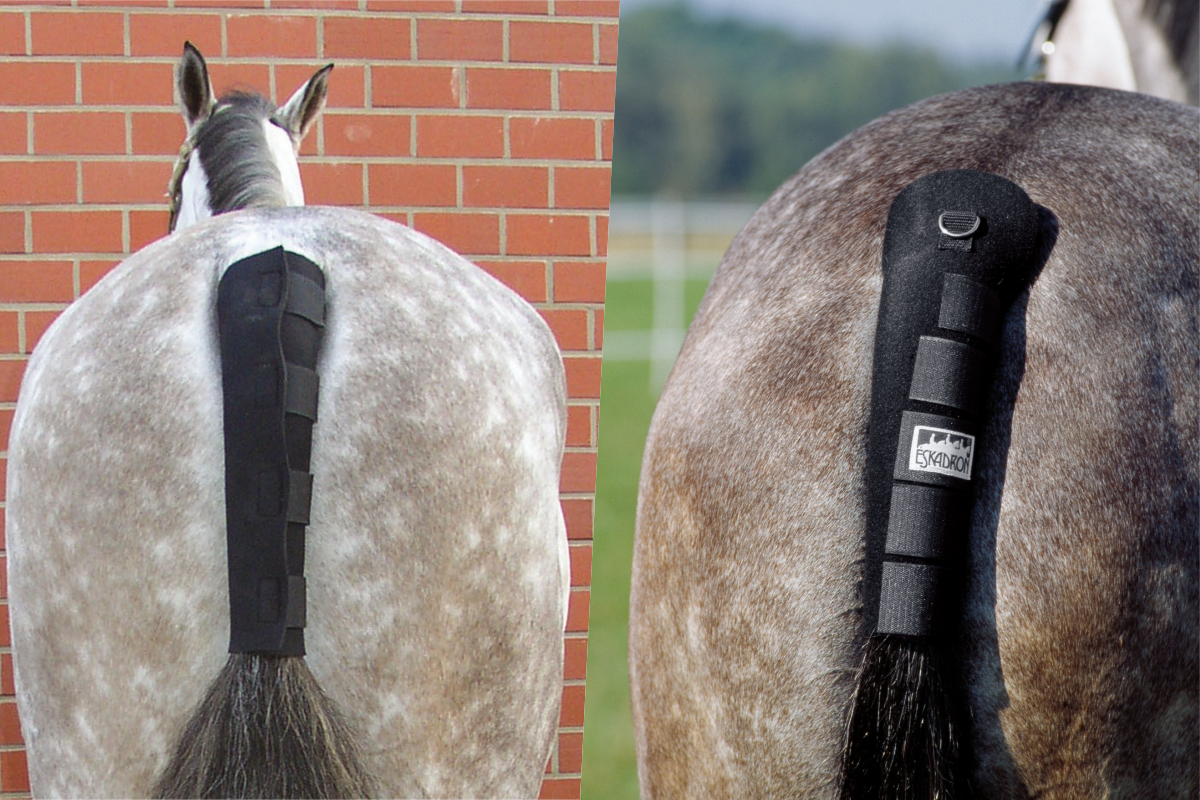
1. Busse Soft Schweifschoner 2. Eskadron Schweifschoner
Schweifschoner - eine sehr clevere Erfindung, die verhindert, dass sich das Pferd am Klettverschluss am Schweif reibt, während es sich während des Transports an die Kruppe lehnt, um das Gleichgewicht wiederzugewinnen. Dieser Schoner wird in Form eines Schweifriemens hergestellt, mit speziellen Riemen entlang des Rückens befestigt und um den Hals des Pferdes gebunden. Wenn wir keinen solchen Schoner haben, besteht eine andere Methode darin, den oberen Teil des Schweifes mit einer Vliesbandage zu umwickeln. Binden Sie es jedoch nicht zu fest, weil dies dazu führen kann, dass Haare aus dem Schweif fallen und in extremen Fällen eine Nekrose der Schwanzrübe verursacht wird, die mit ihrem Abfallen endet. Es wird uns leichter fallen, etwas auf den Schwanz zu legen, wenn wir ihn auf irgendeine Weise flechten – z.B. in einen Zopf.
Achtung!
Wenn wir ein zwei- oder dreijähriges Pferd transportieren, empfehlen wir Ihnen, keine Gamaschen anzuziehen. Der Transport an sich wird ihm ein ausreichendes Ereignis sein, wenn wir ihm neue, unbekannte Ausrüstung hinzufügen, werden sie es nur noch mehr belasten.
1. HKM Halfter mit Morello Fell 2. Eskadron Halfter Fauxfur mit Schnalle
Halfter - für den Transport sollte es bequem sein und nicht scheuern. Halfter mit dem sogenannten "Teddybär" - Fell, das den Pferdekopf an Stellen mit dem größten Druck zusätzlich schützt - am Genick und Nase. Das Halfter darf nicht zu groß sein, weil es beim Transport verrutschen kann. Es lohnt sich auch, Ersatz mitzunehmen, da Karabiner und andere ähnliche Befestigungselemente häufig beschädigt werden (insbesondere bei nervösen Pferden und Hengsten).
5. Anbindung eines Pferdes im Anhänger
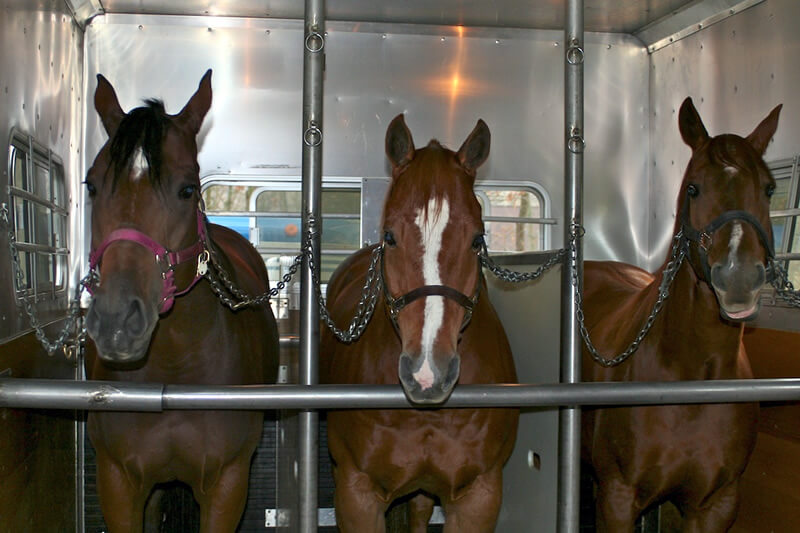 Quelle: www.johnsonhorsetransportation.com
Quelle: www.johnsonhorsetransportation.comDie Grundregel lautet, einen Anbinderiemen mit einem sicheren Verschluss zu verwenden, damit man das Pferd in einer Stresssituation schnell loslassen kann. Wenn das Tier extrem nervös ist, lohnt es sich, es mit dem sogenannten „sicheren Knoten“ anzubinden, der sich mit einem Handgriff lösen lässt, was bei einem Ruckeln und Hängenbleiben des Pferdes durchaus hilfreich ist.
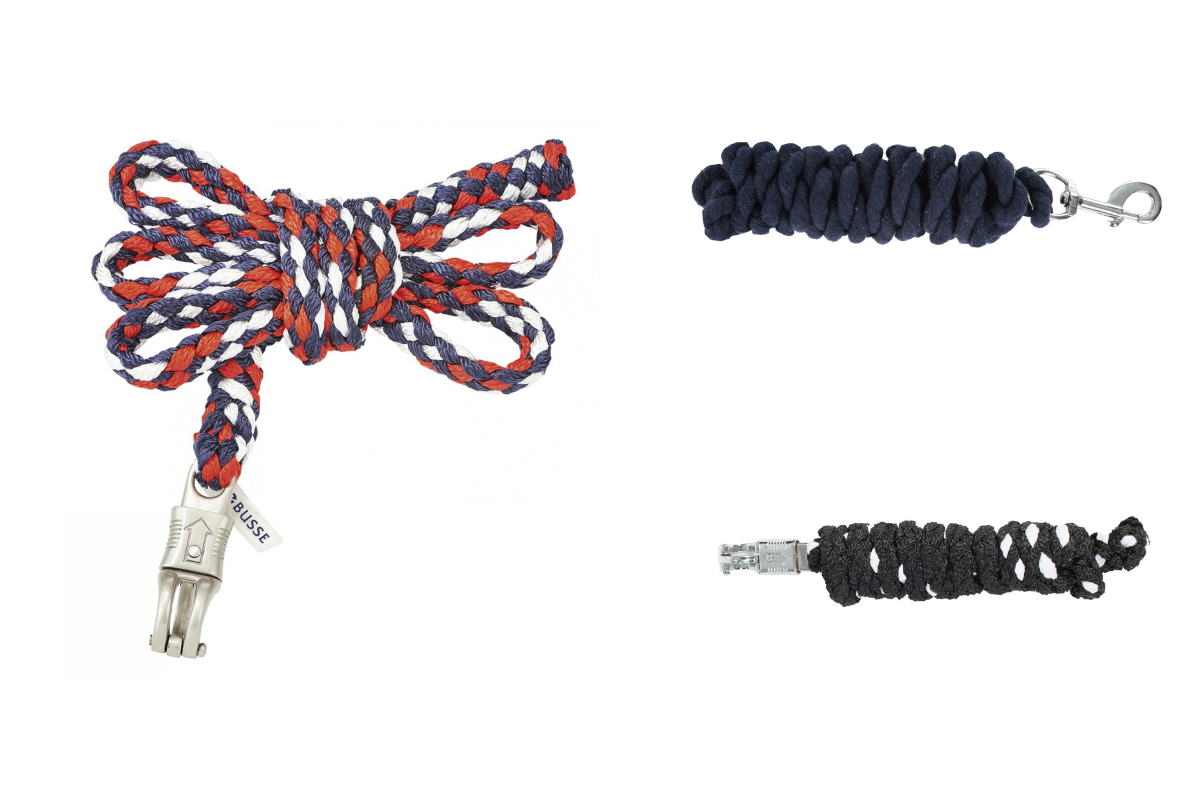
1. Busse Supreme Anbinderiemen 2. Horze Basic Anbinderiemen 3. Horze Nice Anbinderiemen
Wenn wir es mit einem Pferd zu tun haben, das versucht, sich allein zu lösen, denken Sie an eine andere, festere Bindung als die "sichere".
Es ist wichtig, dass die Bindung lang genug ist, damit das Pferd seinen Kopf leicht ausbalancieren kann, um das Gleichgewicht zu halten, und dass sie kurz genug ist, dass sich das Tier nicht umdrehen, seine Beine durch die Leine stecken, seine Gefährten beschnüffeln oder sich unter die Leine beugen kann.
In Anhängern haben wir normalerweise fertige Ketten, die mit einem schützenden Silikon- oder Gummitunnel bedeckt und an den Wänden befestigt sind, sodass wir die Bindungen nicht selbst machen müssen und sie befestigen können, nachdem wir das Pferd hineingeführt haben.
Pferde werden oft mit zwei Anbinderiemen angebunden, um sicherzustellen, dass sich das Pferd während der Fahrt nicht löst.
6. Transport bei kaltem Wetter
An kalten und sogar frostigen Tagen ist es eine gute Idee, Ihrem Haustier eine Decke umzulegen. Am häufigsten werden Vliesdecken für den Transport im Winter und Stalldecken im Herbst und Frühjahr verwendet. Denken Sie jedoch daran, dass zu dicke Decken dazu führen können, dass Pferde schwitzen, was zum Verlust von Elektrolyten beiträgt und ihre Anfälligkeit für Durchzug erhöht, nachdem sie ein beheiztes Fahrzeug verlassen. Wichtig ist, dass die Decke unseres Pferdes einen Verschluss unter dem Bauch hat, der verhindert, dass sie vom Rücken rutscht.
7. Control during the ride
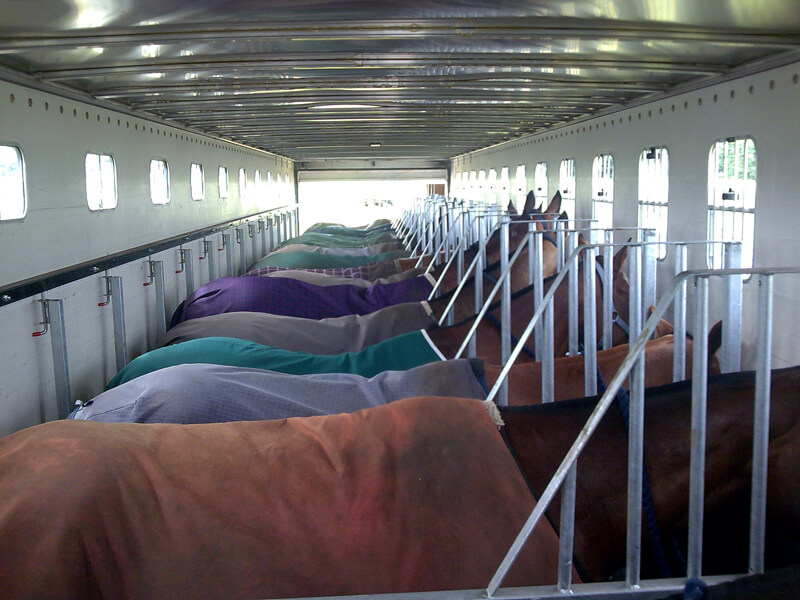 Quelle: horseandman.com
Quelle: horseandman.comLaut Gesetz darf die einmalige Transportzeit eines Pferdes 24 Stunden nicht überschreiten, während Pferde alle 8 Stunden während des Transports für Trinken und Fressen eine Pause einlegen müssen. Aus pferdephysiologischer Sicht ist jedoch ein Transport von mehr als 8-10 Stunden absolut nicht ratsam. Besonders an heißen Tagen müssen wir Zwischenstopps einlegen, um die Pferde zu tränken und abzukühlen. Stellen Sie sicher, dass sie keine Verletzungen haben, dass sie gebunden sind und dass die Gamaschen und die Decke richtig funktionieren. Wenn die Pferde 10 Stunden unterwegs sind, sollten Sie ungefähr in der Mitte der Strecke eine Pause einlegen, in der Sie die Pferde aus dem Anhänger nehmen, damit sie sich ausbreiten, trinken, Stuhl machen und sich entspannen können, indem sie auf dem Gras knabbern.
Derzeit wird in modernen Anhängern der Einbau von Kameras üblich, dank derer der Fahrer und seine Passagiere ständig das Geschehen im Anhänger im Auge behalten und schnell auf unerwünschte Situationen reagieren können.
Darüber hinaus erlaubt uns die Beobachtung von Pferden beim Fahren, Rückschlüsse auf die Reihenfolge, in der die Pferde platziert werden, die Art und Weise, wie sie angebunden werden, um ihre Sicherheit zu verbessern, für die Zukunft.
7. Wenn wir ankommen
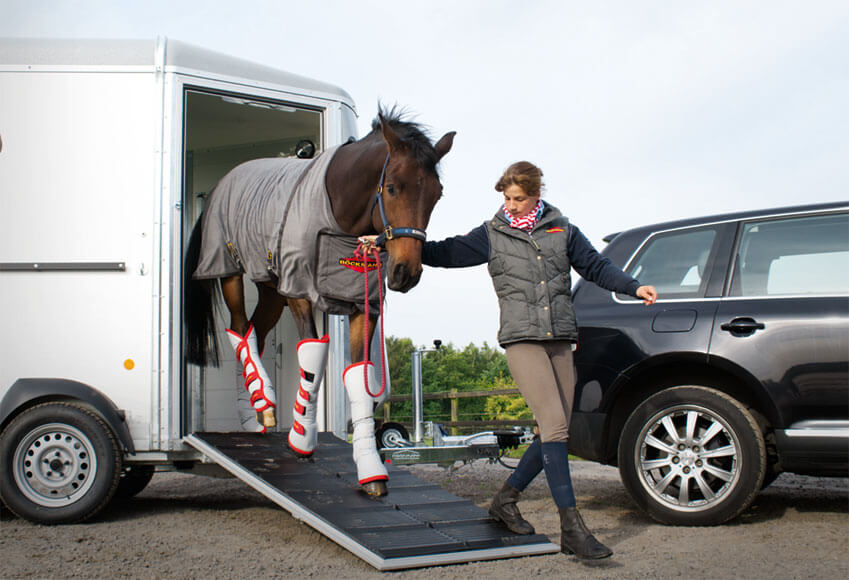 Quelle: www.boeckmann-northamerica.com
Quelle: www.boeckmann-northamerica.comNachdem das Tier angekommen ist und aus dem Transportmittel genommen wurde, muss man ihm Zugang zu Wasser und die Möglichkeit geben, seine Beine auf der Wiese auszubreiten und einen Moment der Entspannung zu genießen.
Achtung!
Wenn das Pferd nach dem Transport heiß oder verschwitzt ist, sollten Sie seinen Zugang zu kaltem Wasser einschränken, es wie einen Athleten nach dem Training behandeln, eine Abschwitzdecke anziehen und mit ihm spazieren gehen, bis es trocken ist. Erst dann können Sie ihm Wasser geben, aber vorher prüfen Sie, ob es nicht zu kalt ist.
Während sich das Pferd ausruht, lohnt es sich, seinen Körper genau zu untersuchen, ob es beim Transport irgendwelche Wunden erlitten hat, insbesondere an Beinen und Hufen. Neben der Möglichkeit von Verletzungen können viele Pferde nach einem langen Transport eine Bewegungssteifigkeit aufweisen. Ihre Muskeln werden hart sein und oft schmerzen – dies ist für uns ein Signal, dass eine Muskelentzündung nach dem Transport vorliegt. Dieses Problem darf nicht unterschätzt werden. In einer solchen Situation sollten wir von einer Teilnahme am Turnier absehen. Ein solches Tier bedarf einer besonderen Behandlung – ein langsamer Spaziergang, das Zudecken des Tieres mit einer Decke und die Verabreichung von Präparaten, die Aminosäuren und Antioxidantien enthalten (z.B. Vitamin E, Selen).
Achtung!
Massieren Sie die Muskulatur nicht zu intensiv und reiben Sie keine wärmenden Mittel ein – das schadet nur noch mehr!
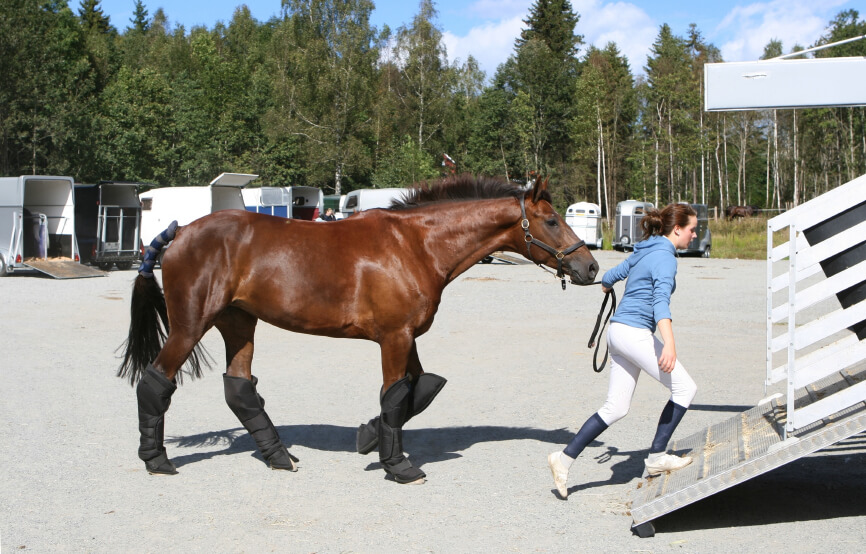
Quelle: libertyhorse.se
Zusammenfassend hängt es von uns ab, ob der Transport für unser Pferd ein angenehmes oder ein Horror Ereignis wird. Je nachdem, wie viel Zeit wir dafür aufwenden wollen und wie gut wir uns vorbereiten. Denken Sie daran, dass alle vorbereitenden Aktivitäten durchgeführt werden sollten, bevor wir mit dem Verladen des Pferdes beginnen, und es am besten ist, dies nicht am Tag des Wettbewerbs zu tun, wenn uns die Geduld fehlt und wir keine Zeit haben. Es wäre schade, dass ein schlecht durchgeführter Transport nicht nur unseren Start im Turnier ruiniert, sondern unser Pferd auch länger aus dem Sport ausschließen würde.











